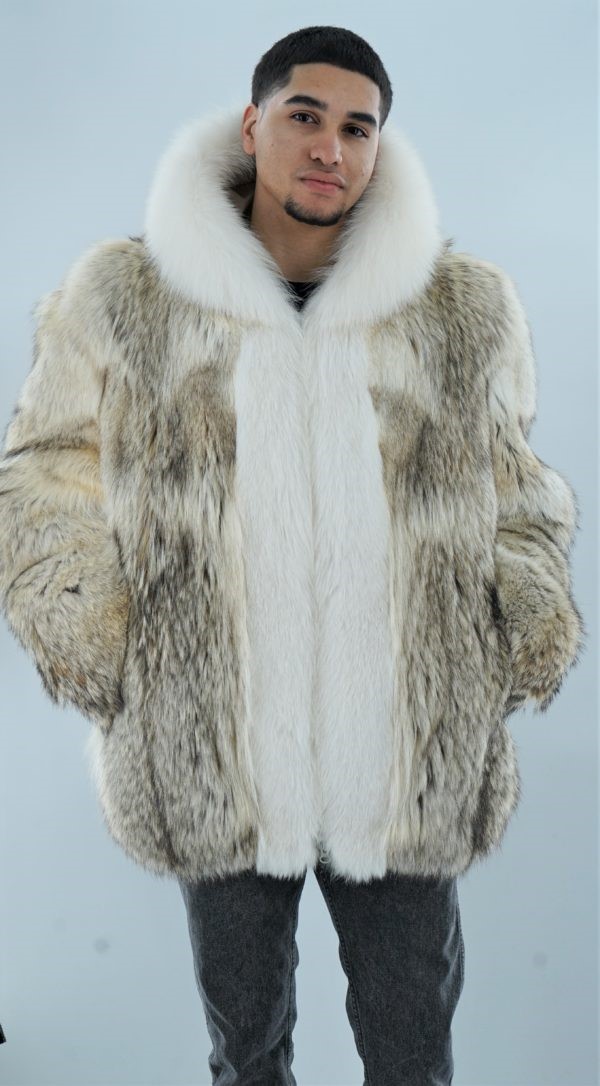Faux Fur Vs. Real Fur | Which Is More Sustainable?
To no surprise, consumers find it extremely difficult to differentiate between faux fur vs. real fur. Some brands and designers do not declare themselves as fur-free, owing to animal rights activists’ claims.
The main reason backing this up is that faux furs aren’t any less evil than real furs. Just because a fashion article is animal-free does not mean that it isn’t hurting the environment. In this blog, we will discuss how real fur is better and more sustainable than faux fur.
Black Shearling Jacket Grey Hood 2299
Alt image text: A girl wearing black shearling jacket with fur trims
We already have a pivot point; one is hurting the food chain, while the other is hurting the entire ecosystem. Nevertheless, let us put all the bias aside and look from an environmental lens to figure this out neutrally.
A Little Scientific Advocacy Never Hurt Anyone!
While real furs come from real animals, faux furs come from chemical polymers that resemble plastic structures and are outstandingly cheap. Both of these are processed and converted into luxurious fashion articles. Fur coats, whether real or faux, are a symbol of opulent fashion.
So, if the outcome is the same, which fur type is the wiser decision? If you believe that killing animals for producing fashion clothing articles for humans is immoral, your argument is valid. However, did you know that there is no scientific or measurable evidence behind this argument?
Fashion advocates think it’s okay to ignore animal welfare because there is simply no way to measure or quantify it. Above that, animal rehabilitation centers are working to ensure food chain sustainability. Some farms inhabit local animals for the fur industry. Additionally, no brand is killing endangered species for the benefit of any human.
That Is Not All of It!
We are not saying that killing animals for human consumption is fair. However, no evidence proves that killing animals can disturb the ecosystem. All the articles and information you will find in respect to this subject, mostly comes from animal activists or the fur industry. Thus, all of this information is biased, does not tell you the whole truth; let us give you an example:
Remember the article published by a couple of animal rights organizations: The environmental impact of mink fur production? It says that real furs are worst for the environment. A competitive article by the name: A comparative lifecycle analysis says that faux furs are far worst for the environment.
See, the question of which is better than which has zero scientific arguments and research backups. One thing yet to realize is that both of these types are harming something. Real furs are hurting animals for human comfort, while faux furs hurt the whole planet for a clothing article.
So, Who’s Right?
The answer to which fur is the lesser of the two evils depends on various factors. Of course, neither is justified, hurting animals or the entire planet. So, we will only try to make it simple if you are a fur-lover.
1. The Nature of the Animal Matters
A study published by the fur-free alliance shows that 1Kg carnivorous fur produces more toxic emissions and eutrophication than herbivorous. One way to tackle this challenge is by switching to herbivore furs, for example, rabbit furs. Rabbits are herbivores, and their usage reduces the carbon-footprint automatically. Thus, more sustainable and less endangering for the environment. Now compare the rabbit fur with polyester. Without a doubt, rabbit furs will top the sustainability criteria. According to the study published by close-the-loop, synthetic fabrics take 20 to 200 years to start decomposition.
Alt image text: A woman wearing pink rabbit fur vest
2. The Upbringing of the Animal Matters
Let us explain this using the Coyote example. National Geographic reports that Coyotes extended their territories after their biggest enemies, i.e., wolves, were stamped out. They prey on baby caribous and put this vulnerable population at high risk of extinction. No wonder they are so abundant, and their existence is a threat to other species. Considering all the facts mentioned, isn’t wearing a Coyote fur coat is better for the environment than faux fur? The choice is yours.
Men’s Coyote Fur Jacket White Fox Trim Hood 7778
Alt image text: A man wearing white coyote fox fur trim hood
3. The Fur Upcycling Process
No wonder faux furs look more and more luxurious with each minute passing. It is mostly because of industrial advancements and technological upgrades. Nevertheless, there are zero instances where one can recycle a faux fur coat. Contrarily, with real fur coats, undoubtedly, you can recycle and remodel your grandma’s 80s coat.
Even if you do not want to remodel your vintage fur coat, you can donate it to animal rehabilitation centers.
Alt image text: A woman wearing vintage rabbit jacket
4. The Fur Longevity You Desire
Let us head straight to the pro-fur study published by Huff Post. They compared a 30 years old real fur mink coat to a six-month-old faux fur coat. The study showed that the faux fur coat exhibited four times more damage risk than the real one.
Additionally, it was 2.7 times riskier for environmental consumption and climate change. It also had the risk of hurting human health if kept for another six to eight months. Thus, if durability and safety is a concern for you, consider real fur coats. There is nothing fancy about the faux fur coat you got for $50, which will fall apart within six months.
5. The Ultimate Question: The Biodegradability
We know natural furs come from animals, and they biodegrade. Isn’t that why we need special storage and maintenance for them? However, we are not sure how long faux fur will take to decompose. Scientifically, faux furs are plastic synthetics spun into threads. They usually come from spandex, polyester, and acrylics.
These plastic fibers can take anywhere around 500 to 1000 years to initiate the process of decomposition. We have often heard the accusations made on the fashion industry like water contamination, fish poisoning, and likewise.
According to a study, plastic processing has intoxicated 83% of the tap water samples obtained globally. If you love the planet, you should love vintage fur coats too.
Final Words
In short, we are not here to accuse faux furs as something from which you should refrain. We debated the repercussions and benefits of each type of fur. Everything comes with its pros and cons.
Real furs have various types and options, and some of them are really good for the environment. Contact Marc Kaufman today; we have the biggest collection of high-quality real fur coats. We provide the best fur types at the most reasonable prices, so call us today!



